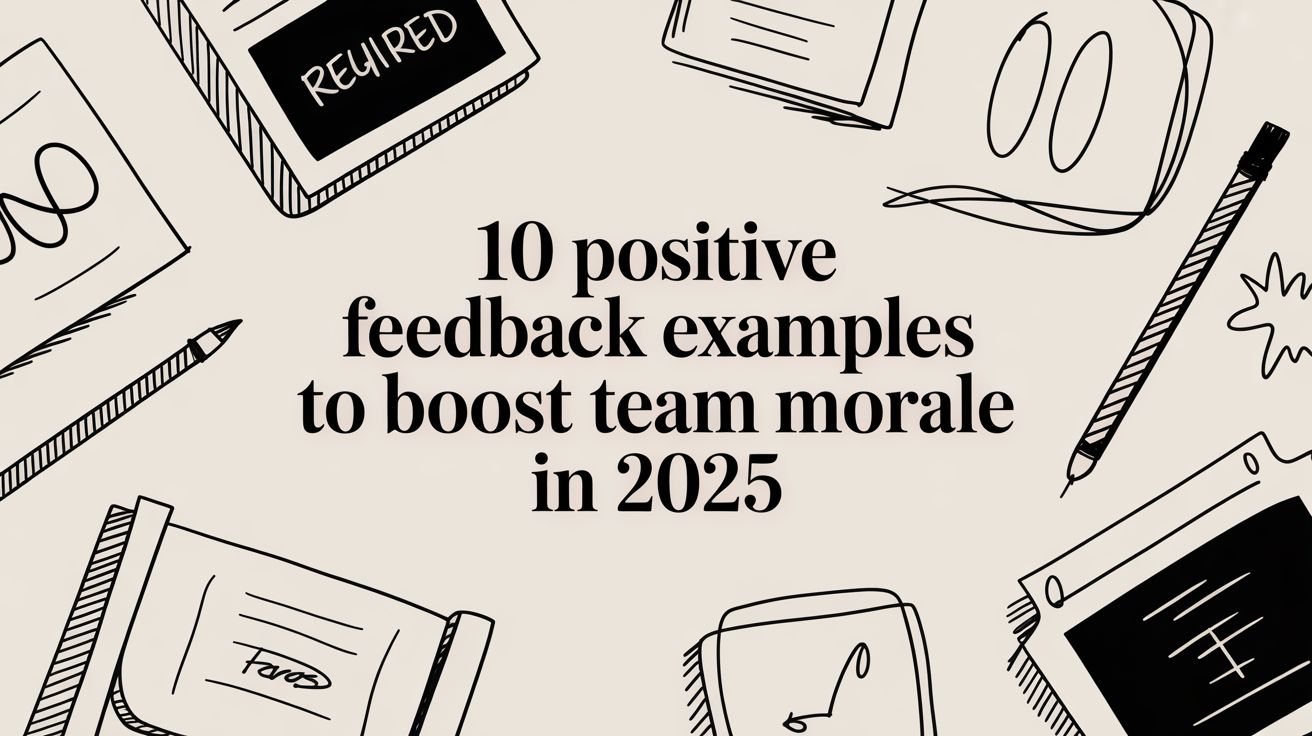In today’s fast-paced workplace, recognizing your team’s contributions is more critical than ever. The importance of team recognition cannot be overstated; it’s the foundation of a positive culture that drives both engagement and retention. Generic praise like ‘good job’ or ‘great work’ often falls flat, failing to inspire or reinforce the specific behaviors that drive success. The true power lies in delivering well-crafted, exact, and timely positive feedback. This is a core element of meaningful team recognition, transforming simple acknowledgments into powerful motivators.
Table of Contents
This guide moves beyond the basics to provide a comprehensive collection of positive feedback examples you can use immediately. We’ll explore why specific praise works, how it builds a culture of appreciation, and how it directly impacts engagement, retention, and performance. You will find categorized, practical examples for every situation, from celebrating a significant milestone to recognizing daily collaborative efforts in Slack.
You’ll learn not just what to say, but how to frame your feedback for maximum impact. Each example is designed to be actionable, helping you turn simple words into a powerful tool for employee growth. Prepare to transform your approach with replicable strategies and powerful templates that help build stronger, more resilient teams. We will cover everything from highlighting innovative problem-solving to affirming perseverance on a problematic project.
1. Specific Achievement Recognition
Specific Achievement Recognition moves beyond generic praise like “great job” to pinpoint a particular accomplishment and its impact. This method reinforces the exact behaviors you want repeated by linking positive reinforcement directly to a tangible outcome. It’s one of the most effective examples of positive feedback because it provides a clear, actionable blueprint for future success, showing team members precisely what excellence looks like in their roles.

The importance of this kind of team recognition is its clarity. It validates an employee’s specific effort and skill, making them feel seen and valued for their unique contributions. For managers, this technique helps build a culture of high performance by consistently highlighting and rewarding desired actions and results.
Strategic Breakdown for positive feedback
- Practical Example 1 (Data-driven): “Your detailed analysis in the Q3 report identified cost-saving opportunities that will save the company an estimated $50,000 annually. Fantastic work pinpointing those specific inefficiencies.”
- Practical Example 2 (Skill-based): “The way you structured the client presentation with clear visuals made the complex data incredibly easy to understand. That skill was crucial to getting their buy-in.”
Actionable Takeaways
- Be Timely: Deliver the feedback as soon as possible after the achievement. Timeliness strengthens the connection between the action and the praise.
- Use Metrics: Whenever possible, quantify the impact. Mentioning figures like “$50,000” or a “20% increase in engagement” makes the feedback more powerful.
- Link to Goals: Explain how the specific action contributed to a larger team or company objective. This adds a layer of purpose to their work. This form of team recognition doesn’t have to be expensive; you can learn more about low-cost employee recognition ideas here.
2. Character or Personality Strength Affirmation
Character or Personality Strength Affirmation focuses on validating an employee’s inherent qualities, such as resilience, empathy, or dedication. This feedback goes beyond task-based performance to recognize the core traits that make an individual a valuable team member, building deep-seated confidence and reinforcing positive workplace behaviors. These are powerful examples of positive feedback because they affirm who a person is, not just what they do, fostering a stronger sense of belonging and psychological safety.
This method is crucial for team recognition because it acknowledges the “how” behind an employee’s success. Affirming someone’s perseverance or collaborative spirit encourages them to apply those strengths to future challenges, contributing to a more supportive and resilient company culture.
Strategic Breakdown
- Practical Example 1 (Resilience-based): “Your perseverance during the unexpected project delays was truly inspiring. Your calm and determined attitude kept the team focused and prevented us from falling behind schedule.”
- Practical Example 2 (Collaboration-based): “Your natural empathy and willingness to listen make you the person everyone feels comfortable approaching. That quality is essential for building the trust we need in our team.”
Actionable Takeaways
- Be Authentic: Only highlight traits you have genuinely observed. Inauthenticity can feel like flattery and undermine the impact of the feedback.
- Connect to Impact: Explain how their character strength positively affected a project, a team dynamic, or the workplace environment. This gives the praise tangible value.
- Use Alongside Performance Feedback: Combine strength affirmation with achievement-based feedback to provide a holistic view of an employee’s contribution. Recognizing both character and accomplishment is a key part of effective team recognition.
3. Effort and Progress Recognition
Effort and Progress Recognition praises the hard work, dedication, and growth demonstrated by an employee, even if the outcome wasn’t an apparent success. This approach fosters a growth mindset, popularized by Carol Dweck’s research, by valuing the journey and learning process. It is one of the most potent examples of positive feedback for building resilience and encouraging employees to take on complex challenges without fear of failure.
The importance of this type of team recognition is its role in long-term development. It shows employees that their commitment is recognized and appreciated, motivating them to keep improving and tackling complex tasks. For managers, it’s a key tool for cultivating a culture where learning from setbacks is just as important as celebrating wins.
Strategic Breakdown
- Practical Example 1 (Skill Development): “I’ve noticed how much you’ve improved your presentation skills over the past three months. Your dedication to practicing and seeking feedback is clear, and it’s making a real difference in team meetings.”
- Practical Example 2 (Process Improvement): “The effort you put into learning the new software system shows incredible commitment. Your willingness to dive in and troubleshoot has helped the whole team adapt faster.”
Actionable Takeaways
- Be Specific About the Effort: Instead of just saying “good effort,” point to the specific actions. Mention the extra hours, the new techniques they tried, or the research they conducted.
- Acknowledge the Challenge: Explicitly state that you recognize the task was difficult. This validates their hard work and perseverance, showing you understand the context of their effort.
- Connect Progress to Future Success: Frame their improvement as a stepping stone. Explain how the skills they are building now will contribute to future achievements and to the company’s larger goals.
4. Impact and Contribution Highlighting
Impact and Contribution Highlighting goes beyond recognizing an action to explain its ripple effect on the team, department, or entire organization. This method connects an individual’s work to the bigger picture, instilling a powerful sense of purpose. It is one of the most meaningful examples of positive feedback because it helps employees see that their contributions are not just tasks but vital components of a larger mission.

This feedback style is deeply motivating because it clarifies the significance of an employee’s work, which is a cornerstone of effective team recognition. For managers, it’s a strategic tool to align individual performance with organizational values and goals, demonstrating how every role contributes to collective success.
Strategic Breakdown
- Practical Example 1 (Team-focused): “Your dedicated mentoring of the new hires has significantly accelerated their onboarding. It’s created a stronger, more capable team and has built a more supportive culture for everyone.”
- Practical Example 2 (Process-focused): “The new workflow you designed has reduced project turnaround time by 15% for the whole department. That efficiency directly improves our capacity for innovation and client satisfaction.”
Actionable Takeaways
- Trace the Connection: Clearly draw a line from the person’s specific action to its ultimate positive outcome. Show them the ‘why’ behind their work.
- Quantify the Impact: Use data like percentages or time saved to make the contribution tangible and underscore its value.
- Highlight Collective Benefit: Explain how their contribution helped colleagues, improved a team process, or supported a company-wide objective. This fosters a collaborative mindset.
5. Problem-Solving and Innovation Praise
Problem-Solving and Innovation Praise focuses on acknowledging an employee’s creativity, ingenuity, and ability to tackle challenges with novel solutions. This feedback moves beyond rewarding task completion to celebrate the critical thinking and proactive mindset that drive progress. It’s one of the most vital examples of positive feedback for building an agile, forward-thinking culture where team members feel empowered to experiment and think outside the box.
The importance of this form of team recognition lies in its ability to foster a culture of continuous improvement. By highlighting innovative thinking, managers encourage the entire team to approach obstacles as opportunities, which is crucial for adapting to market changes and staying competitive.
Strategic Breakdown for positive feedback examples
- Practical Example 1 (Proactive Solution): “Your creative solution to the inventory management challenge not only solved the immediate backlog but also created a more efficient system we can use permanently. Your foresight here was exceptional.”
- Practical Example 2 (Creative Contribution): “I was so impressed by how you thought outside the box during yesterday’s brainstorming session. Your suggestion to use gamification for user onboarding was an angle no one else had considered, and it’s sparked a whole new direction for the project.”
Actionable Takeaways
- Highlight the “Why”: Explain what made the solution or idea innovative. Was it the use of new technology, a unique perspective, or a clever combination of existing resources?
- Connect to Future Value: Discuss how their innovative approach can be applied to future projects or challenges. This frames their contribution as a long-term asset.
- Encourage Sharing: Prompt the employee to share their thought process or solution with the wider team. This not only recognizes their effort but also helps upskill others and spreads the innovative mindset.
6. Collaboration and Teamwork Affirmation
Collaboration and Teamwork Affirmation highlights an individual’s capacity to work cohesively with others, support colleagues, and foster a positive team environment. This type of feedback reinforces the cooperative behaviors that are essential to a healthy, productive culture. It’s one of the most vital examples of positive feedback for building a unified team, as it explicitly values the interpersonal skills that enable collective success.

The importance of team recognition for collaboration is immense. By consistently acknowledging teamwork, managers help dismantle silos and encourage a “we’re in this together” mentality, which is critical for tackling complex projects and navigating challenges. It motivates employees by celebrating their role as a team player, making them feel like a crucial part of the group’s fabric.
Strategic Breakdown
- Practical Example 1 (Supporting a Colleague): “The way you proactively supported Sarah by helping her prepare for the client meeting while managing your own workload showed incredible team spirit. Your generosity helped her succeed and strengthened the whole team.”
- Practical Example 2 (Cross-functional Leadership): “Your collaborative approach during the Q4 product launch ensured that every department, from engineering to marketing, felt heard and valued. That inclusive leadership was the key to our smooth execution.”
Actionable Takeaways
- Mention Specific Actions: Pinpoint the exact collaborative behavior, such as “sharing your notes” or “organizing the brainstorming session,” to make the feedback concrete.
- Highlight the Outcome: Connect the teamwork to a positive result, like “it improved our workflow” or “it led to a more creative solution.”
- Acknowledge Team Dynamics: Explain how their actions positively influenced team morale or communication. Recognizing these contributions can be a great way to boost team engagement and recognition.
7. Learning Advancement and Skill Development Recognition
Learning Advancement and Skill Development Recognition recognizes an employee’s efforts to acquire new skills, knowledge, or professional certifications. This type of feedback reinforces a culture of continuous improvement, showing team members that their personal and professional growth is both noticed and valued by the organization. It’s a powerful category of positive feedback examples because it encourages a growth mindset and builds a more agile, capable workforce.
This approach is highly motivating as it validates the time and hard work employees invest in their own development. Recognizing skill acquisition is crucial for team recognition and overall morale, as it helps retain top talent by demonstrating a commitment to their long-term career path.
Strategic Breakdown
- Practical Example 1 (Certification-based): “Your new certification in project management has clearly strengthened your ability to lead complex initiatives. It really shows in how smoothly the recent product launch is progressing.”
- Practical Example 2 (Informal Learning): “I’m so impressed by how quickly you’ve mastered the new CRM software. The fact that you’re now proactively helping others learn it is a huge asset to the team.”
Actionable Takeaways
- Connect to Application: Always link the new skill to its practical impact on their work or the team’s goals. Show how their learning is already delivering value.
- Acknowledge the Effort: Recognize the time and dedication required for professional development, whether it was an evening course, a certification exam, or self-study.
- Encourage Sharing: Promote a learning culture by encouraging them to share their new knowledge, perhaps through a quick team training session or by mentoring a colleague.
8. Resilience and Perseverance Acknowledgment
Resilience and Perseverance Acknowledgment is about recognizing an employee’s ability to navigate challenges, bounce back from setbacks, and maintain focus under pressure. This feedback doesn’t just praise the final result; it celebrates the arduous journey and the strength shown along the way. As one of the most impactful examples of positive feedback, it reinforces that effort and tenacity are as valued as success itself.
The importance of this feedback is its role in building a psychologically safe and supportive culture. By highlighting grit, you show that setbacks are part of the process, which encourages innovation and strengthens team morale. It communicates that the organization values character and persistence, making it a critical form of team recognition.
Strategic Breakdown
- Practical Example 1 (Overcoming a Setback): “Despite the significant setback with the client, I admired how you regrouped, adjusted your approach, and ultimately exceeded their expectations. Your perseverance turned a potential loss into a major win.”
- Practical Example 2 (Grace Under Pressure): “Your ability to stay calm and focused during the system outage was incredible. It helped everyone else maintain perspective and work collaboratively toward solutions instead of panicking.”
Actionable Takeaways
- Acknowledge the Difficulty: Start by explicitly recognizing that the situation was challenging. This validates their experience and makes the praise more meaningful.
- Describe the Behavior: Pinpoint the specific resilient action you observed, whether it was staying calm, rethinking a strategy, or motivating others.
- Connect to the Outcome: Explain how their resilience positively impacted the team, project, or client. This shows the tangible value of their perseverance and is a key form of team recognition.
9. Initiative and Leadership Recognition
Initiative and Leadership Recognition highlights moments when an employee steps beyond their defined responsibilities to lead, innovate, or proactively solve a problem. This feedback is crucial for cultivating an ownership mindset, where team members feel empowered to take charge without waiting for explicit instructions. As one of the most forward-looking examples of positive feedback, it not only validates current actions but also actively identifies and nurtures future leaders within the organization.
Recognizing initiative sends a powerful message that autonomy and forward-thinking are valued, encouraging others to adopt a similar proactive stance. For managers, this form of team recognition is vital for building a resilient and self-sufficient team capable of navigating challenges without constant oversight.
Strategic Breakdown
- Practical Example 1 (Proactive Problem-Solving): “Your initiative in identifying the workflow bottleneck and creating a new documentation process before it became a major issue shows real leadership. That foresight saved the team from potential project delays.”
- Practical Example 2 (Stepping Up): “The way you stepped up to coordinate the cross-departmental project while Sarah was on leave demonstrated maturity and capability. You filled a critical leadership gap and ensured everything ran smoothly.”
Actionable Takeaways
- Describe the Specific Initiative: Clearly state the action the person took without being asked. Pinpointing the exact moment of initiative makes the praise more concrete.
- Note Leadership Qualities: Use words that highlight leadership traits —such as “foresight,” “ownership,” “maturity,” or “proactivity” — to reinforce these behaviors.
- Discuss Future Potential: Frame the feedback in the context of their growth. Connecting their actions to future leadership opportunities makes the recognition a developmental tool. This kind of team recognition is a powerful, low-cost way to invest in your people’s careers.
10. Customer-Centric and Service Excellence Affirmation
Customer-Centric and Service Excellence Affirmation highlights an employee’s exceptional dedication to client satisfaction. This feedback recognizes when a team member goes above and beyond to meet customer needs, reinforcing the critical link between great service and business success. As one of the most impactful examples of positive feedback, it shows employees that their efforts to create a positive customer experience are recognized and highly valued.
This approach is vital for building a customer-first culture. For managers, affirming service excellence not only motivates the individual but also sets a clear standard for the entire team, demonstrating what outstanding customer support looks like in practice and encouraging repeat behaviors that drive loyalty. This is the ultimate goal of customer-focused team recognition.
Strategic Breakdown
- Practical Example 1 (Going Above and Beyond): “The extra effort you took to resolve the client’s issue at midnight, even though it wasn’t technically your shift, exemplifies our commitment to customer success. That dedication is exactly what turns a frustrated customer into a loyal one.”
- Practical Example 2 (Proactive Problem-Solving): “Your attention to detail in customizing the solution for our client’s unique needs didn’t just solve their problem; it turned them into our strongest advocate. That proactive approach is invaluable.”
Actionable Takeaways
- Share Customer Voice: Whenever possible, include direct quotes or positive customer feedback. Hearing it straight from the client makes the recognition more powerful and authentic.
- Describe the Specific Action: Pinpoint the exact service behavior you are praising, such as “staying late,” “customizing a solution,” or “patiently walking them through the process.”
- Note the Outcome: Connect the employee’s action to a positive business result, like improved customer satisfaction scores, a contract renewal, or a positive online review. This form of team recognition reinforces customer-centric values.
Comparison of 10 Positive Feedback Examples
| Feedback Type | 🔄 Implementation Complexity | ⚡ Resource Requirements | 📊 Expected Outcomes | 💡 Ideal Use Cases | ⭐ Key Advantages |
|---|---|---|---|---|---|
| Specific Achievement Recognition | Medium — needs concrete examples and timing | Low — quick if data available | High — clear behavior reinforcement and memorable | Performance reviews, project results, promotions | Reinforces exact behaviors; reduces ambiguity |
| Character or Personality Strength Affirmation | Low — simple wording but must be genuine | Low — minimal prep time | Medium — builds confidence and emotional connection | One-on-ones, morale boosting, coaching | Strengthens identity and long-term self-worth |
| Effort and Progress Recognition | Low — focus on observable improvements | Low — limited time to note progress | Medium — encourages persistence and growth mindset | Learning journeys, developmental feedback, transitions | Motivates continued effort and resilience |
| Impact and Contribution Highlighting | Medium–High — may require tracing outcomes | Medium — time to quantify or collect examples | High — increases sense of purpose and alignment | Strategic projects, mentoring, cross-team initiatives | Connects actions to mission; boosts intrinsic motivation |
| Problem-Solving and Innovation Praise | Medium — evaluate novelty and effectiveness | Medium — may need review or validation | High — encourages creative risk-taking | R&D, process improvements, brainstorming sessions | Promotes innovation and scalable solutions |
| Collaboration and Teamwork Affirmation | Medium — observe group dynamics and specifics | Low–Medium — gather examples from peers | High — strengthens team cohesion and culture | Cross-functional projects, team-building efforts | Reinforces cooperative behaviors and support |
| Learning Advancement & Skill Development Recognition | Medium — link skill to application | Medium — verify certifications or outcomes | Medium–High — builds capability and retention | Training completions, role changes, upskilling programs | Encourages continuous learning and career growth |
| Resilience and Perseverance Acknowledgment | Medium — requires context and sensitivity | Low–Medium — may need background knowledge | Medium — builds coping skills and confidence | Crisis response, recovery from setbacks, high-pressure tasks | Validates persistence and composure under stress |
| Initiative and Leadership Recognition | Medium — assess ownership and impact | Low–Medium — document actions and outcomes | High — identifies leaders and drives accountability | Succession planning, gap-filling, proactive projects | Encourages ownership and leadership development |
| Customer-Centric & Service Excellence Affirmation | Low–Medium — cite customer evidence when possible | Low — leverage customer feedback or metrics | High — strengthens loyalty and reputation | Client-facing roles, service recovery, CX programs | Reinforces customer-first behavior and quality service |
Putting Feedback into Action: How to Build a Culture of Recognition
The journey through these diverse examples of positive feedback reveals a powerful truth: team recognition is not a one-size-fits-all practice. From praising a specific achievement to acknowledging quiet resilience, the most effective feedback is tailored, timely, and exact. It moves beyond a generic “good job” to articulate the why behind the praise, connecting an individual’s actions directly to team success and company values. The importance of team recognition is that it reinforces the behaviors that lead to a thriving, innovative, and supportive workplace.
The core lesson from our exploration is that feedback is a tool for reinforcement. When you highlight initiative, you encourage proactive problem-solving. When you celebrate collaboration, you build stronger, more cohesive teams. Each practical example we’ve covered provides a blueprint for shaping the behaviors you want to see more of.
From Examples to Ecosystem
Understanding these templates is the first crucial step. The fundamental transformation, however, happens when you embed them into your organization’s daily rhythm. An authentic culture of recognition isn’t built on sporadic, top-down announcements. It thrives on consistent, genuine, and peer-driven appreciation that flows through the work.
To make this a reality, consider these actionable steps:
- Lead by Example: As a manager or HR leader, make a conscious effort to use one new type of feedback from this list each week. Your consistency signals that recognition is a priority.
- Lower the Barrier: Make giving praise as easy as possible. Encourage short, Slack-ready messages and peer-to-peer shout-outs. Remove any friction that might prevent someone from sharing a quick word of thanks.
- Create Visibility: Recognition that happens in private is valuable, but public praise amplifies its impact. It not only rewards the recipient but also broadcasts what success looks like to the entire team. This creates a powerful learning loop for everyone.
Making Recognition an Effortless Habit
The ultimate goal is to operationalize appreciation, turning it from a manual task into an automated, celebrated habit. Integrating tools that facilitate and amplify these interactions directly within your communication platforms is key. For instance, a Slack app specifically designed for team recognition can transform the entire process. It turns feedback into a simple, engaging routine right where your team already collaborates.
By making recognition an effortless and integral part of your company’s DNA, you build a resilient, motivated, and highly engaged workforce. The positive feedback examples in this guide are your building blocks; now it’s time to construct a lasting culture of appreciation.
Ready to turn these examples into a daily habit? AsanteBot integrates directly into Slack, making it simple for anyone on your team to give meaningful recognition, celebrate wins, and build a stronger culture of appreciation. Discover how easy it can be to amplify positive feedback by visiting AsanteBot today.




